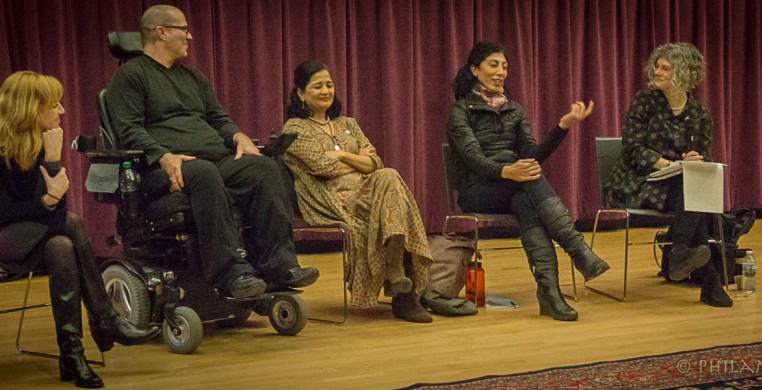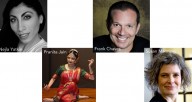December 19, 2014 | Moving Reflections
By Zachary Whittenburg
The Myron R. Szold Music and Dance Hall is one of those ingeniously convertible studio-theater spaces, with raked seating for 150 that collapses completely into one wall. The Old Town School of Folk Music configures it in a variety of ways, depending on what kind of event it will host. When fully extended, the theater seating leaves open a modest stage primed for solo musicians and small bands; divide in half the room’s space for performers and viewers and you’ll get a roomy black box for choreography and about 75 audience members. On December 8, the hall’s blonde, hardwood floor was wide open with a generous, Navy blue and maroon rug in the center.
Around the rug were chairs in a circle, three panelists and a moderator for the final “Moving Dialogs” conversation of 2014. Titled “Global Exchange,” it gathered artistic directors Frank Chaves, of River North Dance Chicago since 1993; Pranita Jain, founder the following year of Kalapriya Center for Indian Performing Arts; and Nejla Yasemin Yatkin, who formed NY2Dance in 2000. Susan Manning, Professor of English, Theatre and Performance Studies at Northwestern University, helmed their conversation after welcoming us attending in person and those watching online.
The early part of the panel generated an atlas of place names starting with Cuba, where Chaves left at six months old and recently returned for the “trip of a lifetime,” he said. Jain discussed her beginnings dancing in India and going back, to Jaipur and elsewhere. Yatkin related growing up Turkish in the divided city of Berlin and following opportunities from there to Chicago, to Denver, then to Ohio, Colombia, El Salvador and beyond. Each panelist clarified how he or she was a contemporary choreographer, as opposed to one working strictly within codified or classical techniques, and yet two of them readily admitted to having a “first language” in dance.
“Jazz,” said Chaves. “Jazz all the way.”
“Bharatanatyam still feels…” Jain said, then clenched both her fists. “It’s so in there.”
Yatkin remembered how, as a child, she “was interested in anything that moved” but dove deep later in life — as a dancer for Cleo Parker Robinson’s repertory ensemble and Dayton Contemporary Dance Company — into modern techniques developed here. “Graham, Horton, Limón, that very linear work: I wanted to be absorbed by it,” she said.
Communication requires fluency to some degree. Before a baby learns to speak, he or she can only cry out in need — for food? A blanket? To be changed? To be held? The answer requires detective work. Once they’ve grown, people realize how words can fail them in other ways, so they learn body language and how to take the temperature of a silence. Sometimes your first language includes the vocabulary you need, but sometimes it doesn’t and so you have to create your own.
“My transition has been in process for over a decade,” said Jain. “I’m navigating a different social system of audience over here.” This time last year, she was finalizing Kalapriya’s contribution to Redmoon Theater’s Winter Pageant, based loosely on The Conference of the Birds by 12th century by Sufi poet Farid ud-Din Attar. For the fast-moving, athletic piece — an excerpt from which was shown on video — the Kalapriya dancers wore shoes. “Ten years ago, I would’ve said that would never happen,” she delcared, “but to move forward, I said okay, yes: We will dance in shoes.”
It was quickly evident during Yatkin’s introduction of her video work sample that her recent projects draw from sources far beyond Graham, Horton and Limón. Called OASIS: Everything you ever wanted to know about the Middle East but were afraid to dance, the NY2Dance production addresses identity, spirituality and torture, “sometimes satirically, through Turkish shadowplay mixed with Western and Middle Eastern forms,” she explained. We saw footage of dancers silhouetted behind screens and isolated in drop spotlights; three men wearing black hoods, yanking on the limbs of a fourth clad in nude briefs; and Yatkin herself, kneeling with an open book held over her face as if it were a veil.
Chaves, while rooted in distinctly Chicagoan approaches to jazz dance, as typified by Gus Giordano and Hubbard Street founder Lou Conte, joked that “the older I get, the more Cuban I realize I am. That passion, the sensuality, the musicality in particular: Everything that I did was very intricate and syncopated, rhythmically.” This reconciliation of his American training and Caribbean heritage culminated in Havana Blue, a 2013 collaboration between River North and Orbert Davis’ Chicago Jazz Philharmonic. Their creative process included the aforementioned “trip of a lifetime” to Havana, during which Chaves saw more than a dozen dance companies and music groups, and sat in on a rehearsal led by Alicia Alonso, founder of Ballet Nacional de Cuba. “It really was heaven,” he recalled. “When I set foot there, I felt that I was home.”
He then added that his current fascinations include classical technique and choreography for women en pointe. “I keep going more toward the contemporary, even to the balletic. I find myself heading in that direction — I have less experience there, so I find myself drawn to it.”
These three artists, from my perspective, represent the current norm: An individual who leads an ensemble from one or more places of fluency, who is inspired and intrigued enough by the unfamiliar to incorporate aspects of it into his or her work. But our field needs purists, too, for the ecology of dance to function properly. For every artist who’s developed an idiosyncratic, composite vocabulary, I hope there’s another who’s chosen adherence to an existing lineage, devoting him or herself to its continued survival. Webs of reference break down if their source materials are lost or altered beyond recognition. Lessons learned throughout generations of practice need new teachers who can pass them along — even if most of their students decide it’s ultimately more appealing to break those rules.
According to her bio, Jain “trained for nine years with India’s foremost Bharatanatyam teacher, Padma Vibhushan Sonal Mansingh,” and she’s studied traditional Indonesian, Nepalese and Thai dance forms, too. “I found commonalities,” she reported. “Most are grounded, earthy — not going upward like ballet and some other Western forms.” Even so, the members of her company “are not necessarily Indian or of Indian heritage,” she explained. “They bring their own experiences and training into the studio…and I work with their stories, their elements. It all has to work together in order for us to be able to tell new stories, or, the old stories need to be redefined. What Kalapriya has brought back is not necessarily reflective of classical dance.”
On the other side of her experiences performing other choreographers’ work, Yatkin said that, at this stage of her career, “freedom is at the core. I’ve learned to be more intuitive, more open to what I’m experiencing. I’m coming first to listen, to see, to improvise, to taste.… Movement is at the center, but I collaborate with musicians and videographers.” In response to a question from the audience, Yatkin related her approach to a recent restaging of Wallstories, originally produced in 2009: “We went back to improvisation, so it looks natural and like [the new cast members’] movement, as opposed to my movement.” She spread wide her long fingers, extending her hands in opposite directions. “What can we do with this?” she then asked, bringing her palms closely back together to make a rigid, narrow hallway in the space in front of her.
Playing for a moment with two big rings on his fingers, Chaves explained the realities of his creative process for his latest work, In the End, for six men and premiered during River North’s 25th anniversary engagement in October at the Harris Theater. “It was my first time choreographing from a wheelchair, being so limited in terms of movement. I felt like I had a brand-new experience of what’s next — I’m still in that phase of what’s next,” he said, hitting the armrests of his tall, black powerchair, “from here.”
This discussion on “Global Exchange” wrapped up as everyone mingled over cheeses and wines from various regions, guacamole and other culturally specific dips. Living in Chicago, it’s easy to take for granted the fact that I can sample authentic, global cuisines as easily as I can highly experimental hybrids of them, all within a handful of square miles.
But I’d be willing to bet that we’d lose our international fame for both kinds of culinary excellence if we let either one of them atrophy. It’s all in the dialogue.
Moving Dialogs is an ongoing conversation series produced by Audience Architects that brings together artists and audiences for free, public conversations regarding intersections between dance and culture. Moving Dialogs: “Global Exchange” is funded in part by the Chicago Seminar on Dance and Performance, the Illinois Humanities Council, the National Endowment for the Humanities, the Illinois General Assembly and the Joyce Foundation. Moving Dialogs returns in 2015 with “Moving Dialogs: Cultural Connections” focusing on Chicago-area dance companies that received grants through the MacArthur International Connections Fund. Each public conversation will explore the rich, diverse, cultural learning that occurred within each MacArthur International Connections Fund project. For each event, the panel will include the Chicago choreographer, the international choreographic partner via Skype, and a respected guest scholar with expertise in a relevant field.
Zachary Whittenburg is Manager of Communication at Hubbard Street Dance Chicago and its representative on the Chicago Dancemakers Forum consortium. Follow him on Twitter @trailerpilot.


